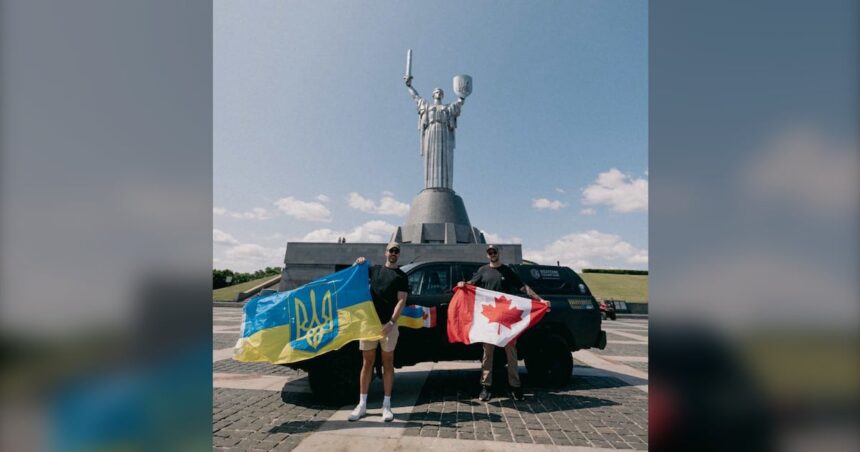The war convoy was supposed to end in eastern Poland. That’s what retired Canadian engineer Bohdan Romaniuk expected when he agreed to help his friend deliver a refurbished military vehicle to support Ukraine’s defense efforts. What began as a logistical assistance mission quickly transformed into something far more personal when his convoy partner suggested, “Let’s just do it. Let’s cross the border.”
I met Romaniuk last week in Kyiv, where he recounted how a planned handoff at the Polish-Ukrainian border evolved into a 14-hour drive through western Ukraine to deliver the armored personnel carrier directly to a territorial defense unit in Lviv. The 68-year-old Calgary resident, whose parents fled Ukraine during World War II, hadn’t planned to enter the war zone. But standing at the border crossing in Przemyśl, Poland, watching refugees flow westward, something shifted in his calculus of risk and obligation.
“My parents would have been proud,” Romaniuk told me as artillery boomed in the distance. “They fled this country with nothing. The least I could do was drive in with something that might help.”
The vehicle—a decommissioned M113 armored personnel carrier purchased through a Canadian-Ukrainian volunteer network—underwent extensive modifications in Poland before the journey. These civilian-led equipment transfers exist in a gray zone of international aid, neither officially sanctioned nor explicitly prohibited by Canadian authorities. They represent a growing phenomenon where diaspora communities provide direct material support to Ukraine’s defense, complementing but operating separately from formal government assistance programs.
According to the Ukrainian World Congress, diaspora-led initiatives have delivered more than $95 million in non-lethal aid since Russia’s full-scale invasion began. The Canadian government has separately provided over $2.4 billion in military assistance, including artillery systems, armored vehicles, and ammunition, according to Department of National Defence statistics.
“It’s not just governments that shape international response to aggression,” said Maria Rypan, director of Ukrainian Canadian Social Services in Toronto. “Ordinary citizens with technical knowledge are finding ways to contribute directly. These efforts occupy a space between diplomatic channels and personal activism.”
The journey wasn’t without complications. Romaniuk and his convoy partner navigated multiple checkpoints, documentation challenges, and the constant anxiety of Russian drone surveillance. They relied on local contacts and traveled mainly at night, avoiding major highways and populated areas.
“We weren’t soldiers or diplomats—just two Canadians with engineering backgrounds delivering equipment that we knew would save lives,” Romaniuk explained. “The Ukrainian soldiers who met us had been waiting months for this kind of transport. One officer told me they’d lost three men the previous week because they lacked properly armored vehicles for evacuations.”
This grassroots approach to military aid represents what security analysts call the “democratization of foreign policy”—where diaspora communities, technical professionals, and volunteers assume roles traditionally reserved for government actors. The approach carries both benefits and risks.
“Citizen-led initiatives can move faster than official channels, but they also raise questions about oversight and coordination,” said Alexandra Chyczij, president of the Ukrainian Canadian Congress. “These efforts complement rather than replace government assistance, addressing immediate needs while formal aid navigates bureaucratic processes.”
The Canadian government maintains ambiguous posturing toward such citizen initiatives. When asked about Romaniuk’s actions, Global Affairs Canada provided a statement neither condemning nor endorsing such activities, instead emphasizing that “Canadians should avoid all travel to Ukraine due to the security threats posed by the Russian invasion.”
Yet these private initiatives continue, driven by cultural connections and moral imperatives that transcend official caution. For the territorial defense unit that received Romaniuk’s delivery, the vehicle filled a critical capability gap in their operations around Lviv, potentially saving dozens of lives through medical evacuations and secure transport.
“We calculated it would take four months to receive similar equipment through official channels,” said Commander Ihor Prytula of Ukraine’s 103rd Territorial Defense Brigade, who accepted the delivery. “Every day without proper equipment means more casualties. These civilian initiatives are keeping my soldiers alive while the larger systems catch up.”
For Romaniuk, the journey transformed his understanding of his heritage and Canada’s role in supporting Ukraine. “I grew up hearing stories about my homeland, but seeing the determination of ordinary Ukrainians to defend their sovereignty made those stories real,” he said. “As Canadians, we believe in supporting democracy and human rights. Sometimes that means taking personal risks.”
The United Nations High Commissioner for Refugees reports that over 6.3 million Ukrainians remain displaced within the country, with another 5.9 million registered as refugees abroad. Each piece of equipment delivered—whether through official or unofficial channels—affects the safety and survival prospects for these populations.
As I watched Romaniuk prepare for his journey back to Canada, he showed me photos of the armored vehicle now bearing a small maple leaf emblem alongside Ukrainian military markings. His hands trembled slightly, not from fear but from the emotional weight of his experience.
“I didn’t come here looking for adventure or recognition,” he said, putting away his phone. “I came because sometimes being a good global citizen means stepping beyond your comfort zone. If more of us did that, maybe fewer people would suffer in silence.”
The story of one Canadian’s unexpected journey into a war zone illustrates how global conflicts increasingly blur the lines between official response and personal responsibility, creating new pathways for international solidarity that exist outside traditional diplomatic frameworks—and raising important questions about how democracies support allies in crisis.






